EBOOK
Jingle Sells: Holiday Ecommerce Marketing
Published: Jul 24, 2018
The most wonderful (e-commerce) time of the year
It’s the most wonderful ecommerce marketing time of the year: Q4 is make or break for most e-commerce retail brands, as shoppers take to the internet, credit cards at the ready, prepared to snap up bargains. But in an ever-changing e-commerce landscape, it’s important to stay agile and approach it flexibly.
This guide will examine the data behind all the key dates in the Q4 shopping calendar so you can know what to expect and how to engage shoppers across the holiday season:
- Singles’ Day: top ecommerce marketing tips for the growing shopping holiday
- Black Friday & Cyber Week: your ecommerce marketing game plan for before, during and after
- Holiday season: the can’t miss ecommerce marketing opportunities to take you into the New Year on a high
Singles’ Day
Many western consumers and retailers are still in the dark about this Chinese holiday celebrating singledom, but 11/11 (the date was chosen because of all the lonely ones) has now become e-commerce’s day of days, thanks to a lot of promotion from Alibaba. Last year, Chinese consumers spent $25bn – four times the amount spent on Black Friday or Cyber Monday.
Much like Black Friday beginning in the US and then jumping the pond to Europe, Singles’ Day is now reaching far beyond China, and is extending to other countries in Asia. For example, Chinese smartphone maker Xiaomi has used Singles’ Day as leverage into other markets, using non-Chinese social networks to promote their offer in countries like Malaysia:

And it’s not just Chinese brands selling beyond China. Non-Chinese consumers are getting in on the action and purchasing in the sales, and non-Chinese brands are investing in the Chinese market (health and nutrition brands like Swisse and Bio Island and baby brands like Aptamil and Moony are among the top foreign brands being purchased on Singles’ Day).
Additionally, there are reports that Chinese consumers aren’t simply looking for discounts on Singles’ Day, but are also looking for high quality imported goods. This means that retailers don’t have to offer deep discounts to benefit from the day, but instead need to create smart ecommerce marketing campaigns to position their products as desirable.
Top ecommerce marketing tips from Singles Day
Whether Singles’ day is something you’ll participate in or not, its rapid rise leaves some lesson to be learned. Here’s what you can take and apply to peaks throughout the year:
- Be mobile first: 90% of Alibaba’s sales came via mobile last year, meaning that the mobile customer journey must be seamless
- Understand your audience: Singles’ Day consumers are mostly digitally savvy millennials using WeChat and Weibo to shop. The top ecommerce marketing tactics make a play for this audience with gamification, celebrity endorsement on social networks, events and live streaming
- Make payment easy: for example, if serving the Chinese market, ensure top payment platforms like Alipay, TenPay and others are integrated into your checkout
- Use data and machine learning to predict a shopper’s next move, serving shoppers the right messaging at the right time in order to increase conversion rates
- Use peer-to-peer recommendations such as social proof
- Create a sense of urgency using countdown timers
Black Friday and Cyber week
While Singles’ Day remains primarily an Asian phenomenon (although we’ve got no doubt the rest of the world will catch on in the years to come), the biggest event on the e-commerce calendar for most western brands is Black Friday (followed by Cyber Monday and beyond).
And if the trends we’re seeing continue, then Black Friday 2018 could be the biggest yet in terms of conversions. Between 2016 and 2017 conversion rate jumped from 3.9% up to 4.8%, driven by increasingly savvy consumers who know exactly what they’re looking for, as well as the fact retailers are getting better at optimizing for conversion.

To succeed on Black Friday, it’s important to realize that this event isn’t just about the day itself, but the lead-up and aftermath as well. Check out the traffic peaks as consumers start doing their research in the days before Black Friday. Note that it remains high, right through until the Tuesday following:
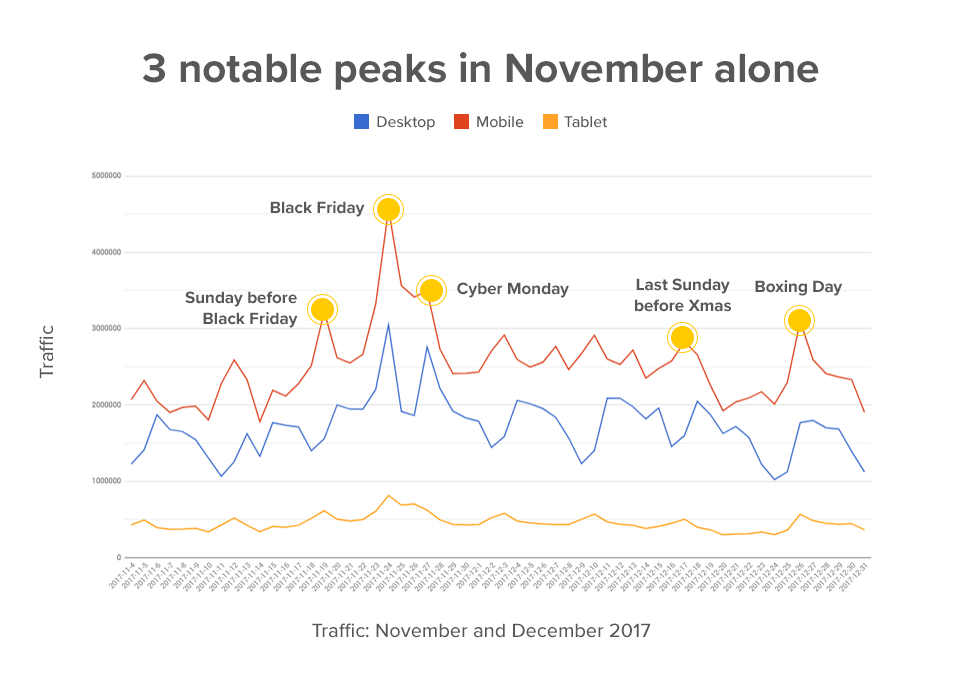
Before Black Friday
What this tells us is that for the biggest e-commerce day of the year, preparations should be starting now. So what should your ecommerce marketing focus on?
Get mobile ready
With two fifths of last year’s Black Friday revenue originating via mobile (not to mention the browsing – 54.3% of site visits were via mobile), there are no excuses for a poor mobile customer journey. But it seems this is still a challenge for many, with conversion rates on this channel still lagging behind, generally half that of desktop and tablet:
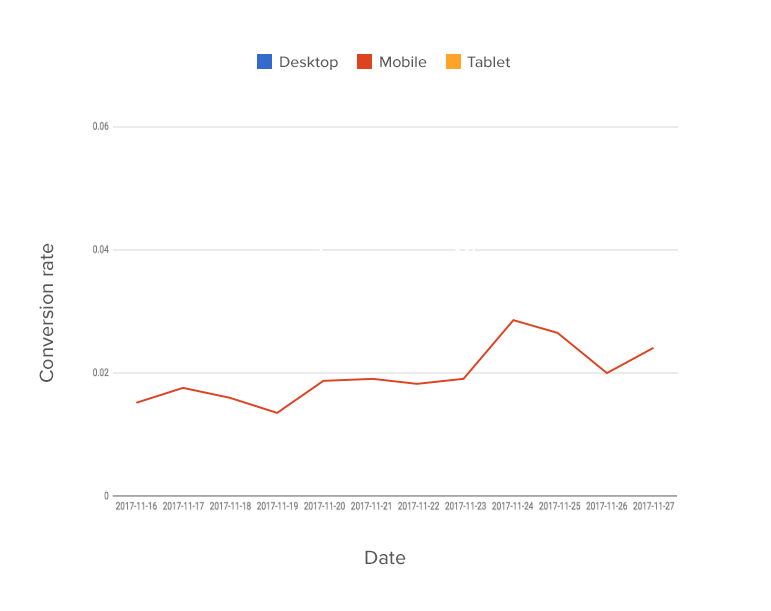
But if this is where the traffic’s going, there’s a real urgency to make sure that the conversion experience follows suit. In the lead-up to Cyber Week, here’s what you need to do to ensure a mobile-best experience:
Test and optimize page speed and server capacity
Mobile shoppers routinely abandon pages that crash or load slowly. With overloaded traffic numbers, sites that crash will face dropping revenues – which is not just lost potential but also sunk cost spent on traffic acquisition.
Ensure the mobile user journey is perfect
Your site navigation and checkout process must be flawless – remember that everyone who faces a complicated sign-up process or clunky user journey could easily abandon to find another retailer.
Expect a bigger leap in traffic than last year
In 2016, mobile traffic was 24% higher than the previous year, and in 2017, mobile traffic was 49.5% higher, according to Yieldify data. 2018 could well see that figure jump again!
Start awareness campaigns early
Black Friday works best when there has been an ongoing conversation with consumers, so it’s essential to start creating buzz early – according to the National Retail Federation, 40% of holiday shoppers start buying before Halloween. Starting this conversation days and even weeks before the event itself across multiple different channels is key here.
By doing this, you can avoid having to rely on the highly competitive paid advertising during the month of November itself – rather, you’ll have warmed up the market so that they will think of you as they enter the research and intent phase.
Additionally, our data shows that the ‘Black Friday Effect’ starts five days before the actual date, so smart marketers will capitalize on the early bird traffic.
Create a multichannel customer journey
Meet your customers where they are. With a detailed and data-driven customer profile or avatar, you’ll be able to target your ideal customer in their preferred manner. This means investing in the campaigns that nudge the customer along the journey to Black Friday conversions in a way that’s informative and seamless.
As the author, motivational speaker and salesperson Zig Ziglar once said, “You can have everything in life you want, if you just help other people get what they want.” In this case, you’re helping your customers find the products that they want via the channels they already use.

Targeted onsite messaging
Use onsite behavior to serve targeted messaging to users. For example, if they’ve browsed a few items but haven’t added anything to the basket – i.e. in research mode – serve a teaser message to let them know that Black Friday sales are coming up, and capture emails in a special Black Friday email list that you can use later to keep people notified of offers, flash sales and discount codes when the time comes.
Communicate with your existing audiences
Retailers typically get the most value from their existing audience and people who have already converted than from a cold lead. That means you can make great use of your email and social networks to reward loyalty. For example, Sephora let Instagram and Snapchat followers in on a sneak peek that they also shared via email:

Create FOMO
Urgency is a hugely valuable ecommerce marketing tactic. Using countdown timers to not only raise awareness that sales are coming up, but also to create that all-important fear of missing out on great deals. Swedish homewares retailer Rum 21 enjoyed a +19% average order rate and a +35.9% conversion rate uplift over the Cyber Week period by serving customers this countdown timer:

During the Black Friday peak
This is when there needs to be all hands on deck. Agility, segmentation and variety are your friends here, keeping users engaged and interested
Leverage the marketing opportunity
Some US and most UK retailers now believe that Black Friday is unprofitable. So why engage? Remember that Black Friday is also a marketing opportunity. Consider opportunities for creating a strong brand connection, such as offering a free gift with purchase, or viewing the discounts as a way to get traffic onto your site while planning for long-term retention and engagement.
Some brands use Black Friday as an ecommerce marketing opportunity without actually engaging in sales at all: for example, US outdoor retailer REI launched its #OptOutside campaign to encourage people to spend the day outdoors, and paid all its employees to take the day off in a publicity stunt:
Work to increase order value
Increasing average order value will massively reduce cost per acquisition. Offer your customers incentives to increase their order, like onsite messaging to let them know about free delivery offers for orders above $X, or helping them discover other items they might like.
Sephora killed two birds with one stone and created an incentive to increase order value offered samples in 2015 to encourage people to increase their order value above $25 (while also creating goodwill and brand rapport by giving an inexpensive gift):

Even better, create a more personalized experience by surfacing offers like this at the relevant moment. Kiehl’s did just that using a Notification based on basket value to highlight the free samples visitors would get if they purchased items worth more than €90.

Deploy email to make the most of peak traffic
Want to know when the most traffic and conversions happen on Black Friday? It’s between 7-8pm. So, if you’ve sent out an early morning email, make sure you’re retargeting your campaign as that peak time ramps up to catch people just before and as they browse during this magic hour.
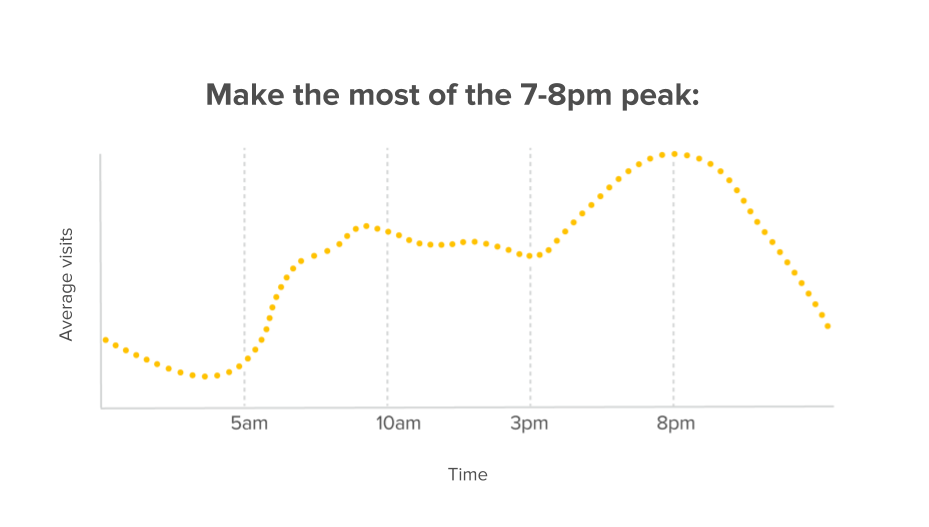
After Black Friday
Traffic tends to dip over the weekend between Black Friday and Cyber Monday, there’s still some after-glow, with visitors returning at the start of the next working week for Cyber Monday and Tuesday. Cyber Monday shows desktop traffic revives after the weekend, meaning there’s a huge opportunity to continue to engage customers.
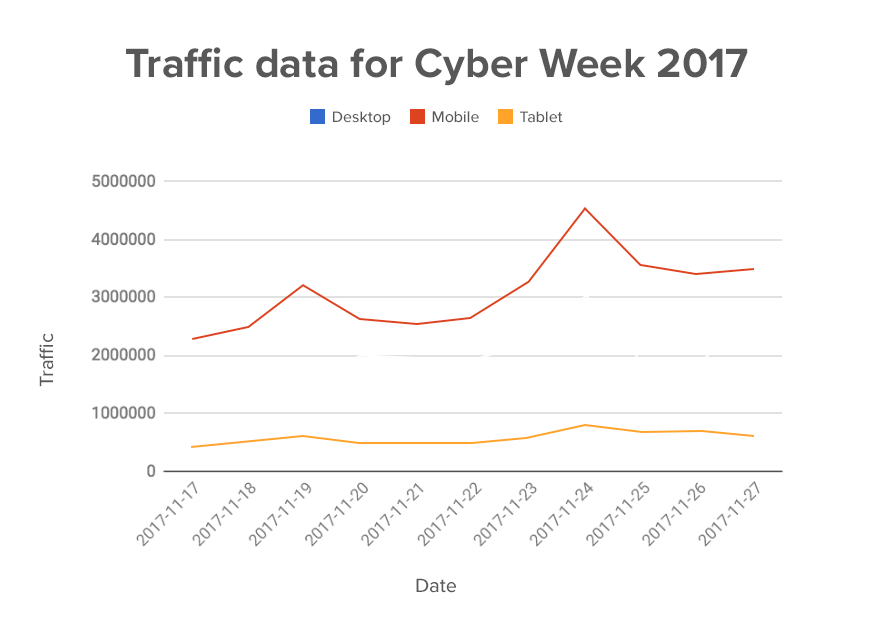
Differentiate to re-engage
Make use of the continued high traffic by offering new reasons to come back. For example, featuring different products, creating hourly offers and launching competitions or flash sales.
Extend your sale beyond the day itself
If your competitors are stopping their sales on Friday itself, push yours a little longer to scoop up shoppers with nowhere to go. In its customer email, ASOS used copy (calling it the Black Friday ‘weekender’) and clearly showed that their sale pushed through to Tuesday morning to communicate that their sales last:

The holiday season
As you can see from the earlier graph, December fares less well for online traffic than the previous month. There are some potential missed opportunities here, so make sure your ecommerce marketing is working hard for you right up until the Christmas break.
Pre-Christmas period
Beware the ‘conversion cliff’
Yieldify stats show that around the middle of December (17th or 18th), there tends to be a drop-off in e-commerce conversions – mainly because customers assume that they’ve missed the boat to get their deliveries before Christmas, and instead return to the high street.
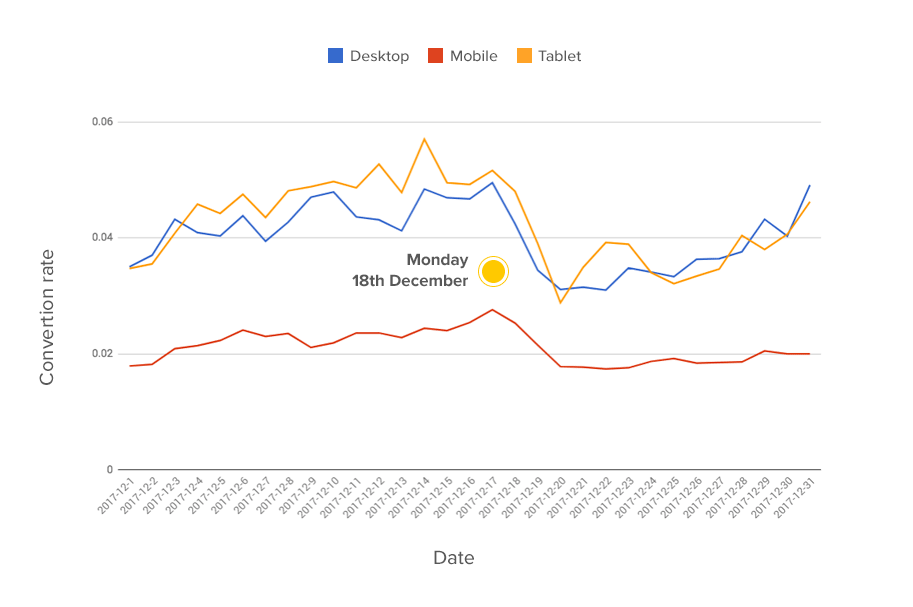
To combat this decline, e-commerce retailers can create messaging campaigns around delivery cut-off dates, for example, by serving overlays directly targeting Christmas shoppers with clear and prominent information about last shipping dates:

And as we’ve already covered, countdown clocks are another effective way to not only communicate shipping cut off dates, but drive urgency to purchase
Christmas Day and Boxing Day
People are increasingly looking to plan out their boxing day bargains on Christmas day itself. UK statistics found in 2017 that early risers were using PCs between 6am-7am (having just put the turkey in the oven, perhaps?), switching to mobile from 8am till 11am (looking to use the gift cards they’ve just received) and with sales peaking during the Queen’s speech at 3pm (no shade to her Majesty). Our own data backs this up:
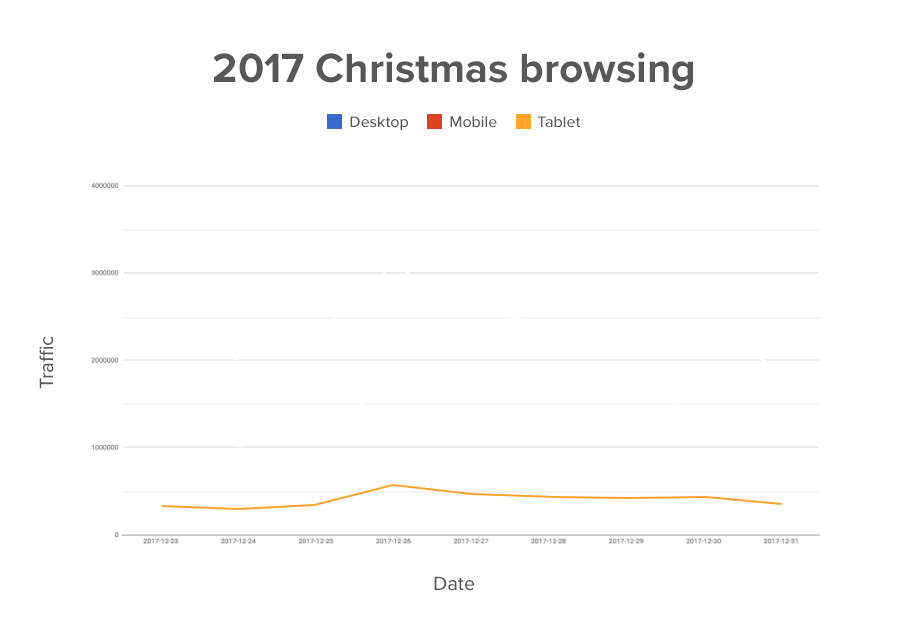
This is a new trend which didn’t really happen in 2016, so we expect another increase to happen for this Christmas. The bottom line? Marketers need to be prepared to launch Boxing Day-specific campaigns as soon as the Christmas promotions end.
Seed Boxing Day sales early
Just like Black Friday, it pays to start the conversation early so that users are already planning their sales activity. Amazon, for example, advertises a whole week of Boxing Day deals, starting from Christmas Day itself:

Boxing Day sales are now a misnomer. The new phenomenon of people browsing on Christmas Day itself is likely to take off, and brands that are prepared to launch sales on Boxing Day will benefit from this uptick.
Re-engage your Black Friday customers
Use smart segmentation campaigns to engage your new customers. This might be in custom overlays based on user data, in email campaigns or in special promotions. Remember that the probability of selling again to existing customers is 60-70% – considerably more than selling to new customers (5-20%). This is the perfect opportunity to start turning newly acquired Black Friday buyers into loyal customers.
Clear inventory
Boxing Day sales are a good opportunity to clear your inventory before the start of the new year. Use scarcity tactics to inspire action in customers, such as showing stock levels and highlighting interest from other browsers.

And in the New Year…
Once you’ve had a moment to catch your breath, it’s time to gather and analyze all the data you’ve accumulated – make sure this insight doesn’t go to waste, as you’ll only benefit from it next time around. The e-commerce brands that survive and thrive in an ever-changing landscape are the ones that review and make decisions based on data. Some key metrics to consider are:
- Cost per acquisition – can you bring it down next year? How can you use loyalty tactics to improve customer retention?
- Returns – were customers returning the items they purchased? At what cost? How can this be reduced next time?
- Conversion rate – was the customer journey effective? What campaigns and tactics saw the best rates? Can these figures be optimized for next year?
As you can see, what were once individual shopping days are now merging into one two-month long shopping holiday – so consider all these individual campaigns as part of a much bigger push to acquire, convert and retain customers. Don’t forget to download your holiday e-commerce checklist, for a bite-size version of this report, and stay tuned for more festive content, data and insights as we approach Q4.